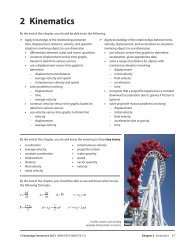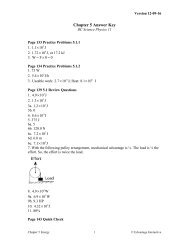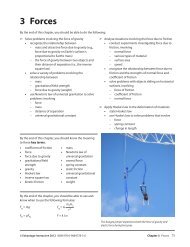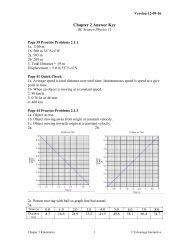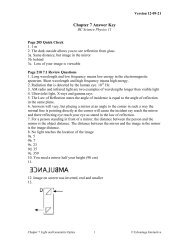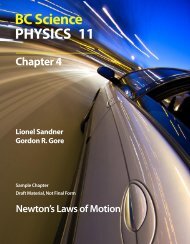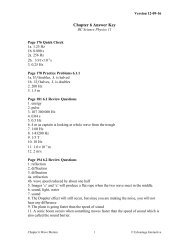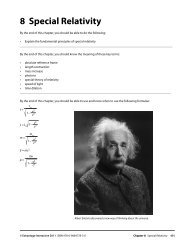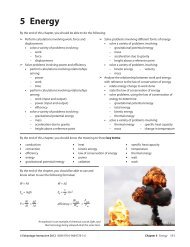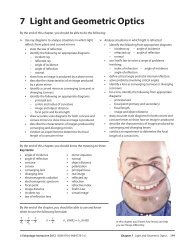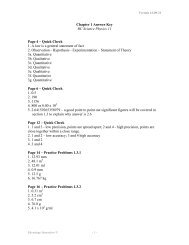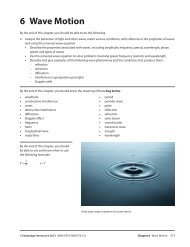4 Newton's Laws of Motion - BC Science Physics 11
4 Newton's Laws of Motion - BC Science Physics 11
4 Newton's Laws of Motion - BC Science Physics 11
You also want an ePaper? Increase the reach of your titles
YUMPU automatically turns print PDFs into web optimized ePapers that Google loves.
Quick Check<br />
1. (a) What is the momentum <strong>of</strong> a <strong>11</strong>2 kg football player running with a velocity <strong>of</strong> 3.6 m/s?<br />
(b) What impulse must a tackler impart to the football player to bring him to a stop?<br />
(c) If the tackle was completed in 0.80 s, what average force did the tackler exert on the other player?<br />
(d) Why is the force negative in question 1(c)?<br />
____________________________________________________________________________________<br />
____________________________________________________________________________________<br />
Law <strong>of</strong> Conservation<br />
<strong>of</strong> Momentum<br />
Any moving body has momentum equal to the product <strong>of</strong> the body’s mass and its<br />
velocity. What makes momentum such an important quantity in nature is the fact that in<br />
a closed system, momentum is conserved. A closed system is one where no outside forces<br />
act on the system. This is the law <strong>of</strong> conservation <strong>of</strong> momentum. In other words, the<br />
total change in momentum within the closed, two-body system is zero. This means that<br />
the total momentum is constant, or that momentum is conserved.<br />
Scientists have done many, many experiments with momentum and are convinced<br />
that momentum truly is a conserved quantity in nature. At the subatomic level in<br />
experiments done with high-energy particle accelerators, physicists rely heavily on the<br />
law <strong>of</strong> conservation <strong>of</strong> momentum in interpreting the results <strong>of</strong> collisions <strong>of</strong> particles.<br />
Conservation <strong>of</strong> Momentum and Newton’s Third Law<br />
Newton’s third law is a special case <strong>of</strong> the law <strong>of</strong> conservation <strong>of</strong> momentum. This can be<br />
shown by using a pro<strong>of</strong>. A pro<strong>of</strong> is a mathematical solution that logically demonstrates<br />
something to be true. The following is a pro<strong>of</strong> showing that Newton’s third law is a special<br />
case <strong>of</strong> the law <strong>of</strong> conservation <strong>of</strong> momentum.<br />
Consider two bodies interacting such that body A exerts a force on body B, and<br />
body B exerts an equal force on body A, but in the opposite direction.<br />
F = – F<br />
A on B B on A<br />
action force = – reaction force<br />
The minus sign indicates that the direction <strong>of</strong> the reaction force is opposite to that<br />
<strong>of</strong> the action force. Using Newton’s second law, written in terms <strong>of</strong> momentum:<br />
© Edvantage Interactive 2012 ISBN 978-0-9864778-3-6 Chapter 4 Newton’s <strong>Laws</strong> <strong>of</strong> <strong>Motion</strong> 123<br />
m B v B<br />
t<br />
= – m A v A<br />
t



